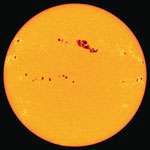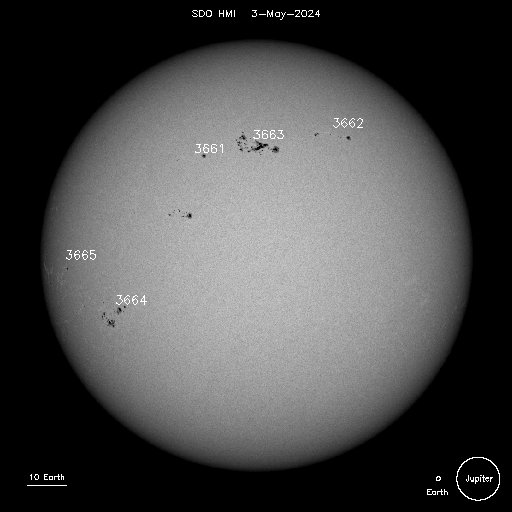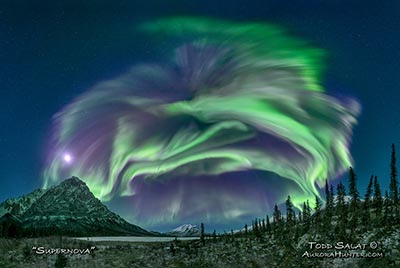Bz = 1.6
247 sun spots
Northern Lights Forecast
27-Day Aurora Forecast

This is a very helpful tool for predicting auroras. On average, the sun rotates on its axis once every 27-28 days as seen from Earth. Therefore, sunspots, like those seen on this solar image to the left, are like a giant revolving firehose emitting energy into space for sometimes months at a time.
After an active aurora night, mark that date on a calendar and in 27-28 days pay close attention to the sky. If that same sunspot (or coronal hole) is still active it will have rotated around with the sun and will be, once again, in geoeffective position (pointing toward Earth)....and hosing us with an enhanced flow of aurora-generating solar wind.
11-Year Solar Cycle
The sun has a heartbeat. Every eleven years or so it beats, and it beats hard. This is known as the solar cycle and is measured by the number of sunspots visible on the sun. The more sunspots, the more solar flare energy is being released into space (which means more aurora activity!).
For 400 years, from the time of Galileo until now, we have been keeping track of the number of these sunspots and, as the trends show in these two graphs, this cycle is predictable.
Q: Where are we now on the solar cycle?
A: The sun is ramping up to Solar Maximum faster than anyone expected. The peak was originally predicted for 2025, but with all the sunspot activity and new modeling techniques, it is now predicted for 2024. The sun is in the midst of flipping its magnetic field right now! This magnetic reversal causes the sun to eject a lot of charged particles into the solar wind. This is good news for aurora hunters because the solar-released energy is the generating force of the aurora. The next few “peak phase” years should all be good.
Best Months?
Aurora Borealis season in northern polar latitudes (Alaska, northern Canada, Greenland, Iceland, Norway, Sweden, Finland and Siberia) runs from August-thru-April. These are the nights with darkness in them. During the summer months of May, June and July it is just too bright to see them in the far northland. Auroras can still be spotted south of about 50° latitude during the summer.
Statistically, the equinox months of September and March are best for aurora activity. The winter months of October-thru-February are also good (there is definitely no shortage of darkness!).
Mythbuster: Contrary to popular belief, it does not have to be cold to see the aurora, just dark and clear....and clear skies usually mean it’s cold, hence the association between auroras and chilly nights.
What Time of Night?
The peak hours are between 11pm and 2am, however, anytime it’s dark there is hope. I've seen the northern lights as early as 8pm and as late as 8am.
Real-Time
Listed below are some websites of organizations that monitor the sun, measure the solar wind in real-time (now), and make aurora predictions. In the explosive event that a coronal mass ejection (CME) is reported it's time to hop into action because this super-charged solar wind is traveling fast (maybe 3-to-5 million miles per hour). When this energy sweeps by the earth 1-to-3 nights later there is a very good chance of aurora activity. It pays to stay tuned in.
Aurora Forecasting Tools
Friday, 04/19/2024
Northern Lights Tonight Page
Current Kp Index
2 Hour Kp Max
1.6
358
Northern Lights Forecast

Aurora Borealis Forecast Tonight

Enthusiast Dashboard
The Sun Now:
Sunspots

Data from SOHO



